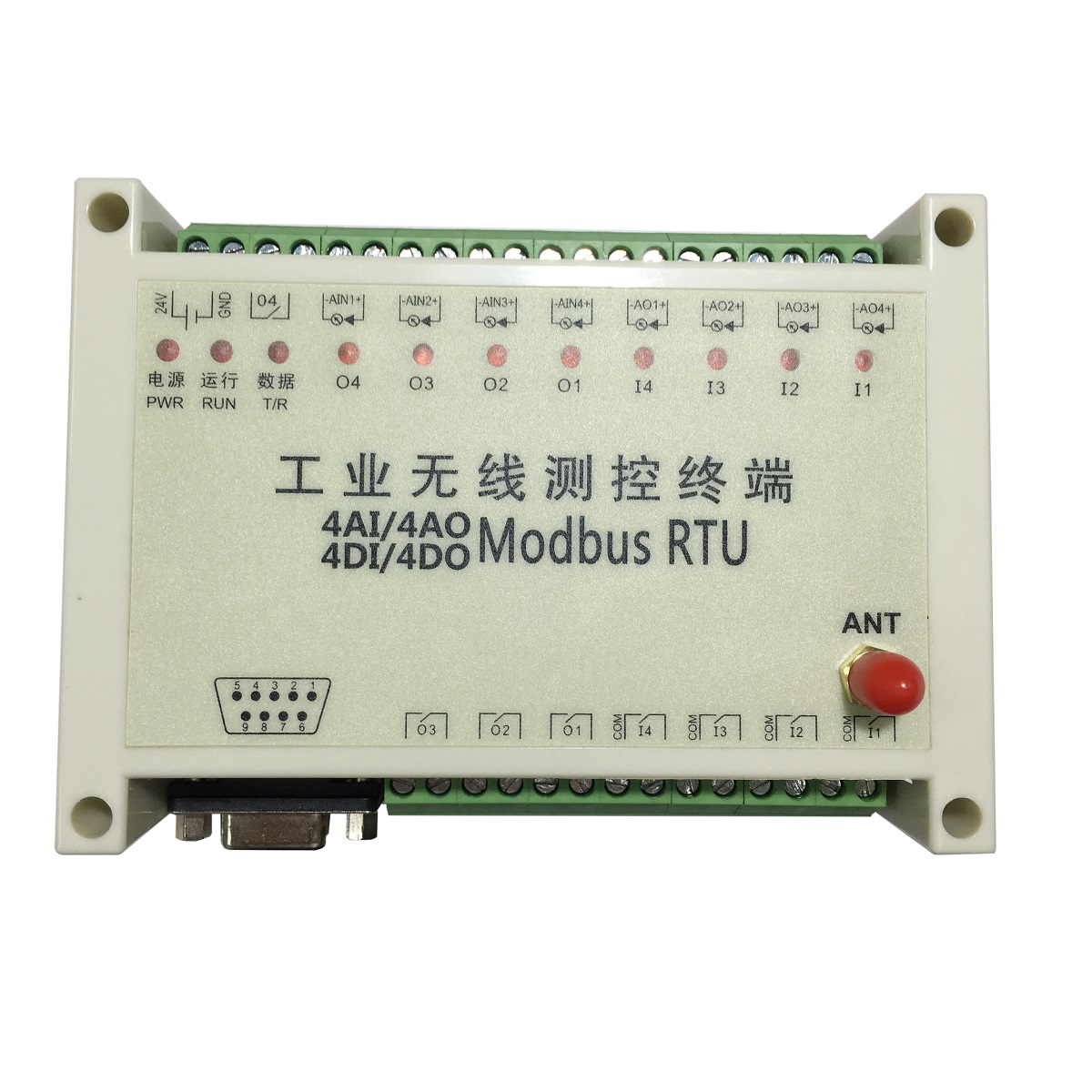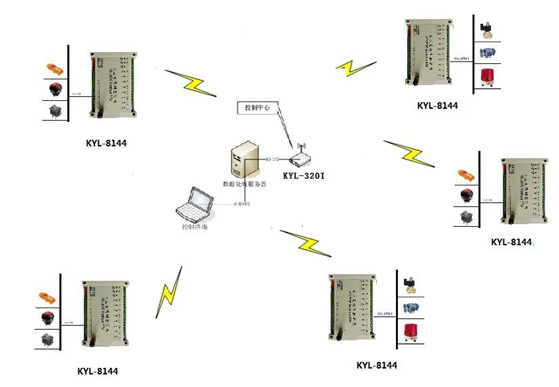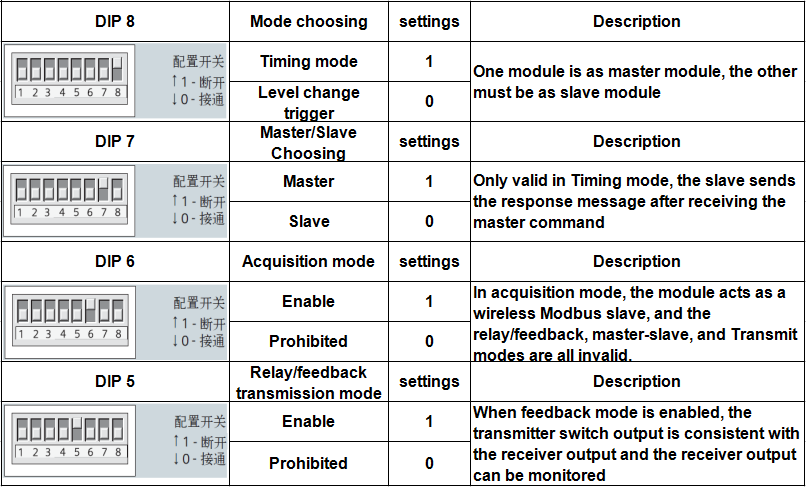KYL-824-LORA

KYL-824-LORA
4-way I/O and 4-way Analog Acquisition Module can achieve wireless transmission in real time.The relay output, voltage and current output of the receiving module are related to the ON-OFF input and voltage/current input of the transmitting module in real time; In other words,when the input of the transmitter switch on,the corespond relay output will be on at the same time.when the input of the transmitter switch off,the corespond relay output will be off at the same time.All channels are independent.No program,no wires,users can remote control switching.This product is widely-used in Industrial controller,wireless monitoring,waterworks automation and other projects.
一、KYL-824 Connection diagram

Wireless water pump automatic control
Wireless sound and light alarm lights
Industrial remote control, industrial site monitoring
Wireless car control
Water plant automation
Traffic Automation Control
Environmental Monitoring System
Oil pipeline monitoring system
| Features | Range | Typical value | Remark |
| Power supply D.C. | 12-30V | 24V | Output current≥500mA |
| Transmission distance | 1-3 km | - | Line-of-sight |
| Transmission distance | - | 4 output | - |
| Output type | - | Relay | Maximum load capacity DC |
| 220V5A | |||
| ON-OFF Input No. | - | 4 input | - |
| ON-OFF Input type I | - | Dry Contact | - |
| ON-OFF Input type II | DC 0-24V | Low level<1V | Low level corresponds to closed |
| High Level>4.5V | High level corresponding to disconnected | ||
| Analog input No. | 4 input | ||
| Analog input I | 0-5V | Default | |
| Analog input II | 4-20MA | Need to be specified | |
| Analog output No. | 4 output | ||
| Analog output type I | 0-5V | Default | |
| Analog output type II | 4-20MA | Need to be specified | |
| Transmitting Current | - | 300mA | - |
| Receiving Current | - | 30mA | - |
| Dimension | - | 145mm*90mm*40mm | - |
Remarks: Analog input and output default 0-5V, if you need 4-20MA input and output, please specify at the time of purchase.
1、 DIP1-4:Channels choosing
Remark:
*Users generally use the inputting change sending mode, DIP7-ON;
*To avoid more than two remote control systems working at the same time in one remote control range, the module for different system should choose different channel (working frequency);
*In timing mode, one must be the master and the other is the slave
*It should be effect by re-power on the module after changing the DIP position.
| Connection name | Pin No. | Definition | Remarks |
| COM1 | 1 | 24V | DC:12-30V |
| 2 | GND | Grounding of power supply | |
| 3 | OUT4(O4) | Fourth channel relay passive contact output | |
| 4 | |||
| 5 | AIN1 | First voltage/current input negative | |
| 6 | AIP1 | First voltage/current input positive terminal | |
| 7 | AIN2 | Second voltage/current input negative | |
| 8 | AIP2 | Second voltage/current input positive terminal | |
| 9 | AIN3 | Third voltage/current input negative | |
| 10 | AIP3 | Third voltage/current input positive terminal | |
| 11 | AIN4 | Forth voltage/current input negative | |
| 12 | AIP4 | Forth voltage/current input positive terminal | |
| 13 | AON1 | First voltage/current output negative | |
| 14 | AOP1 | First voltage/current output positive terminal | |
| 15 | AON2 | Second voltage/current output negative | |
| 16 | AOP2 | Second voltage/current output positive terminal | |
| 17 | AON3 | Third voltage/current output negative | |
| 18 | AOP3 | Third voltage/current output positive terminal | |
| 19 | AON4 | Forth voltage/current output negative | |
| 20 | AOP4 | Forth voltage/current output positive terminal | |
| COM2 | 1 | OUT3(O3) | Third channel relay passive contact output |
| 2 | |||
| 3 | OUT2(O2) | Second channel relay passive contact output | |
| 4 | |||
| 5 | OUT1(O1) | First channel relay passive contact output | |
| 6 | |||
| 7 | GND | ||
| 8 | IN1(I1) | First group ON-OFF input | |
| 9 | GND | ||
| 10 | IN2(I2) | Second group ON-OFF input | |
| 11 | GND | ||
| 12 | IN3(I3) | Third group ON-OFF input | |
| 13 | GND | ||
| 14 | IN4(I4) | Forth group ON-OFF input |
Using Method
1、install the antenna to the module.
2, in accordance with the use of demand, according to the above instructions set the DIP switch, connect the corresponding switch input, switch output device.
3, connect the power (12-30V), turn on the power switch, the power requirements of the output current needs reach more than 500mA.
4, At this point, the input of module can control the output of another module .
5, the module is two-way transmission, that is, a module can as an input ,at the same time, can also be used as a controlled output, and vice versa.
6, Within the same remote control distance range if user using more than two sets of remote control system, one should use a different operating frequency to avoid mutual interference.
Working Mode
1、Triger mode
When ON-OFF input status changed,it will triger I/O Module to send the local status information. This mode has fast speed,can be in real time.Only when input status changed,then will send the signal,the energy consumption will be low.
2、Timer mode
At this mode, there should be one master and one slave module. The master will
synchronize with the slave every 1s, means the master will transmits its condition to slave every 1S and the slave will feedback its condition to master every 1S. If the time master cannot synchronize with slave reaches at 3S, all contacts will disconnect. They connects until the master is synchronizing with slave again. There will be 1s transmission delay at this mode.
3、Collecting mode
At collecting mode, DIP8(transmitting mode), DIP7(master/slave mode) and DIP5(repeater/feedback mode) are all invalid. At this mode, module works as a Modbus slave, it can not transmit data actively. Master can be a PC connecting with a wireless data module or other data terminal. Data terminal sends Modbus RTU
command and requests slave feedback collection condition or control slave’s ON-OFF output. Slave’s ID can be 1 to 254.
4、Feedback/repeater mode
At feedback/repeater mode, receiver will retransmit the command it received and make it reach longer distance. It functions as a repeater. The transmitter will output related ON-OFF condition on its output COM after receiving retransmitted command, meanwhile, the output indicator will be ON/OFF. Its output condition will be the same with its input condition. If receiver didn’t receive the command, it will not retransmit, feedback will fail. Master’s output condition will be not the same with its input. This function can monitor receiver’s output results.If the user is not familiar with the product and is unfamiliar with the method of use, all code switches should be pull to the ON position to test.
KYL-824 Other application
KYL-824 can work with same series I/O Module: KYL-813 or KYL-818 etc,to reach the function of centralized control,and centralized output (please indicate to sales when you set the purchase order).Please look the below diagram as example:

Ordering information
Standard products
| Module Name | Remark |
| KYL-824U | Bi-directional, 2pcs of this RF modules will help you do wireless communication., no program, plastic housing, communication distance 600m-1km (Line of Sight) based on power 100MW |
| KYL-824L | Bi-directional, 2pcs of this RF modules will help you do wireless communication., no program, plastic housing, communication distance 2km-3km (Line of Sight) based on power 800MW |
| KYL-824H | Bi-directional, 2pcs of this RF modules will help you do wireless communication., no program, plastic housing, communication distance 7-10km (Line of Sight) based on power 5W |
| KYL-824P | Bi-directional, 2pcs of this RF modules will help you do wireless communication., no program, plastic housing, communication distance 8-10km (Line of Sight) based on power 2-10W |
| KYL-824+668 | Bi-directional, 2pcs of this RF modules will help you do wireless communication., no program, plastic housing, communication distance 20km (Line of Sight) based on power 25W |
1、Standard accessories
1、1pc KYL-824L module。
2、1pc antenna
Pic.:Standard accessories

2、Selectable accessories
1、Selectable antenna。(Users can choose antenna if need)
Pic.:Selectable accessories











